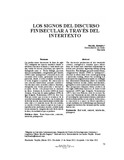Los signos del discurso finisecular a través del intertexto
Fecha
2012-06-30Autor
Palabras Clave
Texto finisecular, Contexto, Intertexto, PalimpsestoEnd Text, Context, Intertexto, Palimpsest
Metadatos
Mostrar el registro completo del ítemResumen
Las producciones discursivas de fi nes de siglo
XX, confi guran un espacio semiótico donde se
advierten relaciones textuales y contextuales que
dan cuenta de nuevas estructuras que aparecen
dialogando entre sí. Dicho diálogo, presenta
diversas modalidades, categorizadas por Genette
(1989) como “palimpsesto”, estructura en la cual
coexisten otros textos, generando una lectura
particular, donde el texto resultante reinterpreta
el texto original o modelo. En consecuencia
esta relación intertextual permite establecer
vinculaciones entre sociedad, cultura y literatura,
otorgando una visión particular e inusual al
receptor. Desde esta perspectiva se analizan
las obras Criaturas de la noche (2000) de Israel
Centeno, Si me han de matar mañana (1999) de
Igor Delgado, Textosterona (1995) de José Luis
Palacios, textos que recrean el acontecer de la
sociedad venezolana fi nisecular, con la intención
de develar las relaciones intertextuales establecidas
entre ellos y el contexto social. En este sentido,
se concibe el texto como el espacio en el que se
reproducen las condiciones sociales, estableciendo
un mecanismo de comparación entre la fi cción de
la obra y la realidad en que se produce.
Palabras clave: Texto finisecular, contexto,
intertexto, palimpsesto.
Colecciones
Información Adicional
| Otros Títulos | The signs of speech end through the intertexto |
| Correo Electrónico | Briceño, Katiuska |
| ISSN | 0798-1570 / Electrónico: 2244-8438 |
| Resumen en otro Idioma | The discursive production of late twentieth century, configured a semiotic space where there are textual and contextual relationships to realize new structures appearing talking among themselves. This dialogue, presents various forms, categorized by Genette (1989) as “palimpsest”, structure in which other texts coexist generating a particular reading, where the resulting text reinterprets the original text or model. Accordingly this intertextual relationship allows to establish linkages between society, culture and literature, giving the receiver a particular and unusual vision. This perspective examines works creatures of the night (2000) from Israel rye, If I have to kill tomorrow (1999) Igor Delgado, Textosterona (1995) José Luis Palacios, texts to recreate the scene end Venezuelan society, with the intention of unveiling the intertextual relations established between them and the social context. In this sense, is conceived as a space in which reproduces social conditions, by establishing a mechanism of comparison between the fi ctional and the reality that occurs. Key words: End text, context, intertexto, palimpsest. |
| Colación | 73-79 |
| Periodicidad | semestral |
| País | Venezuela |
| Publicación Electrónica | Revista Cifra Nueva |
| Sección | Cifra Nueva: Artículos |






